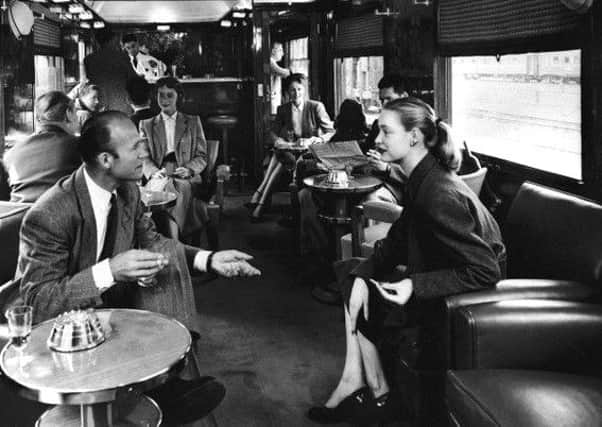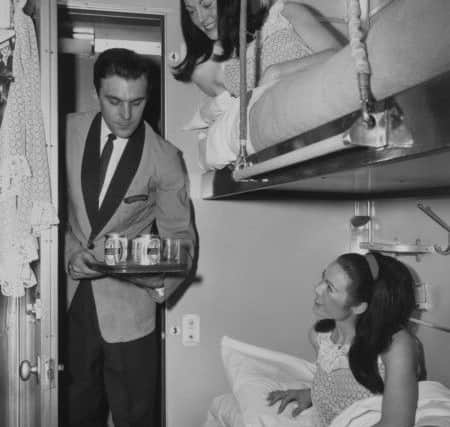The sleepers that add a touch of glamour to train journeys


Andrew Martin can remember the moment he first became fascinated by night trains. It was 1973 and he and his sister were about to head off on holiday with their father.
He describes the sense of eager anticipation as they stood at York station destined for the warmth and sunshine of the Mediterranean.
Advertisement
Hide AdAdvertisement
Hide Ad“I recall the cluster of suitcases on the platform, the patterned summer frocks of the women, some of whom already had their sunglasses on. They took a maternal interest in me and my sister: ‘Now you have brought your sunhats, haven’t you?’ I remember the freshly whitened plimsolls of the men, and the BRTC (British Railwayman’s Touring Club) badges on the lapels of their summer jackets. The badge was circular, with the countries of Europe west of Russia shown in gold against a blue background.”


His father worked for British Rail for 40 years, most of which were based at York, and it’s perhaps not surprising that this rubbed off on Martin, who has made a name for himself with his string of novels featuring railway detective Jim Stringer.
For his latest book, though, he’s combined childhood memories with his intrinsic fascination with railways to look at the enduring allure of sleeper trains wrapped up as they are in a giddy air of nostalgia and excitement.
In Night Trains – The Rise and Fall of the Sleeper, Martin attempts to relive the golden age of the great European sleeper trains by travelling on their modern day counterparts and charting his encounters with people along the way.
Advertisement
Hide AdAdvertisement
Hide AdIt’s not difficult to see the charm of night trains – there’s the sleeping compartments, gilded dining cars, champagne bars, not to mention a dash of old-fashioned glamour.


All of this was conjured up by writers like Agatha Christie and Graham Greene, though the reality could often be equally thrilling, and incongruous: early British travellers on the Orient Express were advised to carry a revolver (and a teapot).
For Martin, his memories of summer holidays are entwined with travelling on night trains. “We had free rail travel and we used to go on holiday to the continent, as it was then called, and it was the most exciting part of my childhood. I remember my dad had a special holiday cravat that he only ever wore when he was abroad,” he says.
“We would travel to Paris and get on the sleeper at the Gare de Lyon and go to either Spain or Italy.”
Advertisement
Hide AdAdvertisement
Hide AdThe famous station at Gare de Lyon with its palm-tree lined platforms and murals is an enthralling experience even for the most world-weary traveller and it’s one Martin recalls fondly.


“I remember after we left the station there would be a knock on the door and you would be given some pillows, sheets and red blankets, which I particularly remember. That was the peak of excitement for me as a 12 year-old kid.
“The sleeper was the whole point of the trip for me. I remember going to Italy and getting heat rash at the beach on the first day and I spent most of the rest of the time in the hotel with the curtains closed looking forward to the sleeper journey on the way back.”
It was these early train journeys through Europe that first piqued his curiosity. “You’d go through Switzerland and at certain points I’d pull the blinds aside when everyone else in the compartment was asleep and look out.
Advertisement
Hide AdAdvertisement
Hide Ad“You’d see mountains, a couple of log cabins and snow capped peaks even though it was summer, it was incredibly cinematic. That’s what got me interested in sleepers.”


In his book, Martin embarks on six different night train journeys across Europe focusing on the network of luxurious sleeper trains run from the 1880s to the 1970s by the Compagnie Internationale des Wagons-Lits. These include the Blue Train from Paris to Nice and, most famously of all, the Orient Express – which originally ran from Paris to Istanbul via several of Europe’s most historic cities.
Travelling on night trains is synonymous with glamour even if the reality doesn’t always live up to expectations. “People think it’s glamorous because a lot of films and novels have featured them. There’s Murder on the Orient Express and The Mystery of the Blue Train and it is glamorous, or at least it was,” says Martin. It was luxurious even if you were in standard class. You had beautiful marquetry and inlays, you had a little reading light by your bed and a small hook from which you could hang your watch.
“In the dining cars you had table lamps that were always silk shaded and polished glass and napkins folded like an upright scallop shell and the chefs were providing cordon bleu meals.”
Advertisement
Hide AdAdvertisement
Hide AdMartin believes the heyday of night trains was between the two world wars before the advent of commercial air travel. “Some people say it declined after the First World War but that’s premature because in the interwar period it was glamorised by the stars of the day. You had people like Scott Fitzgerald travelling to the South of France on one of the ‘blue trains’, so I think its heyday was during that interwar period,” he says.
“Someone said to me the fatal moment was in 1938 when Neville Chamberlain went to see Hitler and came back with a piece of paper saying ‘peace in our time’. Not only was this bad news because Hitler was lying to him but it was also a very public instance of a statesman using an aeroplane rather than a train.”
As air travel grew in popularity so night trains started to decline because there simply wasn’t the same demand. “More recently they’ve been hammered by budget flights, budget coaches and cheap hotels and also high speed trains.”
In France, a number of services are coming to an end including the historic sleeper to Nice, which is due to finish later this year. One of the reasons for their slow demise is the fact high-speed trains can do these journeys much faster, negating the need for overnight sleepers.
Advertisement
Hide AdAdvertisement
Hide AdHowever, Martin says that contrary to what many people perhaps might think, the remaining sleeper services in the UK are still proving quite popular. “The train to Scotland is going to have new rolling stock and I believe they’re refurbishing the one to Cornwall so they seem to have a guaranteed future. The one to Scotland operates after the last flight has left and because of that I think there’s always going to be a market for them.”
They possess, too, perhaps the last vestiges of romance in the functional world of travel. “The key is to get yourself a picnic and half a bottle of wine at the Gare de Lyon if you aren’t having your dinner in the restaurant,” he says, talking about one of his favourite journeys from Paris to Nice.
“You and your partner can get sole occupancy of a compartment for a small premium, and if you wake up early when the train’s meandering slowly along the coast as the sun’s coming up it’s extraordinarily beautiful. You then arrive in Nice with the whole day in front of you.”
Martin says the allure of night trains isn’t just a nostalgic nod to a bygone era. “Most flights I’ve been on tend to just merge into one. Whereas every sleeper journey I could write up without consulting my notes.
Advertisement
Hide AdAdvertisement
Hide Ad“Something always happened, sometimes it might be a problem, but often it was enjoyable and it was always memorable. It’s a proper journey. It’s not just about getting from A to B, it’s an adventure.”
Night Trains – The Rise and Fall of the Sleeper, published by Profile Books, is out now priced £14.99.
Four of the great sleeper journeys
Paris to Nice – The Blue Train from the Gare de Lyon is one of France’s most historic railway journeys and has become synonymous with the glamour of the sun-kissed French Riviera.
Oslo to Trondheim – This seven-hour train journey is best enjoyed during the summer months when you really get to appreciate the stunning Norwegian landscape.
Advertisement
Hide AdAdvertisement
Hide AdParis to Venice – Here you can fall asleep in Paris and wake up in Venice, so you get to enjoy two of Europe’s greatest and grandest cities. Truly, what’s not to like?
London to Penzance – Travelling on the sleeper from Paddington to Penzance is a welcome example of affordable luxury and this remains one of Britain’s great train journeys.